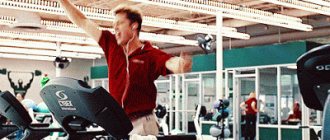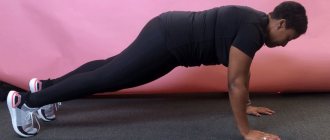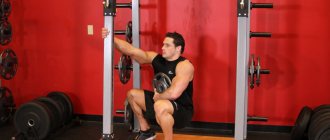What happens to our body during three months of training? And is it possible to notice these changes after the first workout? In today's article we will try to answer these questions and find out how our body and we in general change during 12 weeks of regular physical training.
Have you noticed how crowded gyms are in the last weeks before the summer season? And this is not surprising, because everyone wants to get in shape so they can look good on the beach in the summer. But after a week or two, the excitement disappears somewhere and there are fewer and fewer visitors to the gym... And the reason for this situation is always the same - people stop going to the gym because they don’t see noticeable results. However, “they don’t see” does not mean that they don’t exist!
To prove this, let's take a closer look at what happens to our body over three months of training (three times a week), starting with the first lesson.
Before starting sports
“Training and reasonable changes in lifestyle are the only right way for me, which is the right way to solve problems with health and figure!”
Understanding just this single banal fact gives an incredible boost of motivation. Then you have time for sports, sufficient energy and real metabolic changes!
American researchers have proven that 20% of people began to change in appearance and feel better even before starting training!
This is the very consequence of the first changes in the body - hormonal, psychological, biochemical, which will later lead you to the desired results if you make some effort!
Conclusion: your body begins to change even before you start your first workout!
Half an hour before the first workout
“Now I’ll tear everyone apart!”
This is what your body screams before your first workout. Thinking about exercising can cause your heart rate and breathing rate to increase. Blood pressure may also increase slightly.
If you are an extrovert, you may feel drive and excitement, but if you are an introvert, then, on the contrary, you may feel focused and taciturn. And as you understand, the main thing here is to use this effect correctly and prepare yourself for training (psychological attitude for training).
Conclusion: such reactions of the body indicate that the body feels that it will have to work and begins to prepare for the load in advance!
Nutrition
Protein
Many people don't pay attention to getting enough protein for muscle recovery. If you do the same, you will get very little out of your workout, since both cardio and strength training require a lot of protein to build muscle. I recommend whey or soy protein shakes.
Water
You should drink enough fluids per day. It takes several hours for the body to absorb water, so you should not drink it immediately before training. Drinking water regularly throughout the day should become your habit.
Carbohydrates
Although a low-carb diet can help you lose weight, carbohydrates are the body's main source of fuel. If you are doing intense workouts, then you need to consume carbohydrates, otherwise you will not have enough energy. If you make a smoothie, don't forget to add carbohydrates or a banana - a source of fiber and glycemic carbohydrates, which are needed for exercise.
Cocktail
Drink a shake before and after your workout. It is best to consume a protein/carbohydrate shake immediately before and then immediately after exercise. By drinking such a drink before training, you increase the flow of amino acids into the muscles, providing them with the necessary “building blocks,” so to speak. After a workout, the shake stimulates muscle growth. Also eat a small protein/carbohydrate meal 60-90 minutes after exercise.
During the first training
“My heart is beating fast and it’s become difficult to breathe!”
This is a healthy reaction of the body to physical activity. There is no need to be afraid of it, because it is a completely natural process. You begin to breathe deeper and more often, saturating your cells with oxygen. As a result, the complexion begins to change for the better.
You also don’t have to worry about your heart rate, because it can be affected not only by loads, but also by heat, air humidity, lack of oxygen in the air, overeating before training, menstrual periods, stress and even loud music!
Changes also occur in the muscles. They begin to become more actively saturated with blood and even swell (after training, this effect goes away)! In addition, long-forgotten and little-used muscles, which remind of themselves with a slight aching pain, also become toned.
And you become not only stronger, but also more resilient, stronger, more energetic and more cheerful. During physical activity, a “hormonal storm” begins in the body, which triggers and accelerates slow metabolic processes. The body is literally renewed.
There is also a release of adrenaline and other hormones, the nervous system is excited, which leads to a sharp improvement in well-being and increased energy! Paradox!
Conclusion: even during the first lesson, qualitative changes begin to occur in the body of every person!
Pay attention to aerobic fitness
Cardio is widely known as the best way to lose weight, but aerobics doesn't have to be limited to the gym. According to Edward Jackowski, the famous author of books on fitness training, any physical activity significantly speeds up weight loss. Walk at a brisk pace and take the stairs instead of the elevator more often to get an extra cardio boost.
As for your gym routine, try to increase your aerobic activity to 60% of your total time. Powerlifting and stretching shouldn’t be written off either, just don’t lean on them.
The advantage of aerobic fitness classes is their duration. It’s difficult to find a person who can withstand strength training for the same amount of time as cardio, but to start burning fat you need to train for at least 30 minutes. At the same time, it is important to work at full strength, because only intense training will make your metabolism accelerate to its full potential. How can you tell if you are being lazy? It’s very simple: if you breathe steadily and are able to do a few more sets, be sure to do them.
30 minutes after the first workout
“I am filled with a feeling of joy and pride! I did it (was able)!”
Oh, these familiar experiences to many after the first successful exercise in their life =)! And for good reason, because even after 30 minutes after training, active changes are still occurring in the body, in particular, this concerns the increased production of endorphins, which together with them bring an incomprehensible feeling of joy and euphoria.
Conclusion: the positive emotions received after training will not only lift your mood for a long period of time, but will also be a great incentive to go to training again! After all, you will want to experience these sensations more than once.
Guidelines for duration
For example, we can offer you the following gradation:
- entry level – 20 minutes of warm-up and 10-15 minutes of main training;
- intermediate level – 20 minutes of warm-up and 20-25 minutes of main training;
- high level – 20 minutes of warm-up and 40-50 minutes of main work + cool-down;
- advanced level – 20 minutes of warm-up and 1-1.5 hours of main work + cool-down.
Here again you need to proceed from your conditions and characteristics. It is quite possible to do the work more compactly, but more intensively and maintain high results.
As you can see, there are 20 warm-up minutes everywhere, which are used to engage the body in the fat burning process. This is not observed in strength training, where it is quite possible to warm up with the exercise itself with minimal load and then move on to sets. Losing weight works a little differently.
During the warm-up, you don’t have to overexert yourself; the goal is not fatigue or intensity. The main effort is made precisely in the active phase, and the warm-up phase only launches the necessary processes. At the beginning of your workout, you can use it like walking or lightly pedaling an exercise bike.
2 days after the start of training
“My whole body aches and hurts!”
The feeling of soreness is not only an inevitable stage after the first training, but even more so – necessary! After all, this means that your muscles grow and become beautiful and pumped up! Therefore, for many athletes such pain is even very pleasant =)
You shouldn’t be afraid of this process, because it won’t always be like this. Your body is just adapting to the stress and the soreness will go away over time.
By the way, to reduce body aches, you can take a hot bath or go for a massage. Stretching will also help.
Conclusion: it hurts - it means it’s growing! Therefore, “get high” from this pain, like athletes, imagine how your body becomes toned and beautiful.
You do the same thing
If you want to see real results, you need to create conditions to which the body will constantly adapt and develop accordingly. In reality, this means that your training program needs to be changed. In fact, any training program will work for about six weeks, especially if you haven't trained before or have taken on something completely new.
But by sticking to the old methods, you are unlikely to get new results. As the body adapts to the load, we need to shock it with something new, more complex, so that it does not stop adapting and changing. This is the basic principle of adaptation to stress.
The main thing here is without fanaticism. As with everything, it’s important to find your sweet spot in training. You need to stick with one program long enough to get the hang of it and achieve some success, but not too long that you become stuck.
A general recommendation for most would be to change the program every six weeks. But here everything is individual: some respond better to changes and accept innovations with pleasure, while for others it is quite difficult to change their usual way of life. A well-planned program is essentially a series of separate programs that build on one another with gradually increasing load. There is no need to make changes for the sake of changes: you just need to take this important factor into account.
Whatever deadlines you set for yourself, the main thing is that your workouts are not monotonous. It is necessary to make structured changes to the program, gradually increasing its complexity, especially if we are talking about weight training.
2 weeks after starting training
“Regular training has practically become part of my usual schedule!”
This is not surprising, because scientists have proven that a person develops habits within 2-3 weeks.
Do you remember that unbearable pain after training? Surprisingly, she disappeared =) Therefore, it’s time to do various exercises and not worry about not being able to get out of bed the next day. However, you shouldn’t overload yourself; always remember about moderation and a gradual rate of increase in loads!
Conclusion: you and your body get used to regular exercise, and also begin to master a variety of exercises and techniques for performing them!
Are you used to working from Monday to Friday?
Most of us plan our workouts and proper diet only on weekdays, from Monday to Friday. And when the weekend comes, we relax and catch up on what we missed, didn’t eat or drink. If you just need to stay in shape, this approach is not bad. But this approach will not bring progress, especially if your physical fitness is already very good. It’s just that most of us are not aware of how many extra calories we accumulate when we unconsciously consume food. Add to this partying late into the night with lots of alcohol and you won’t see any results.
This especially applies to those who are extremely strict with themselves during the week, and when Friday comes, they fly off the handle and begin to abuse what they wanted so much all week. We also make excuses: “you deserve it!” For most, it would be much better to spread the restrictions and assumptions evenly across the days of the week rather than jumping from one extreme to another.
It’s simple: you can treat yourself, say, on Wednesday, so that you don’t feel so strongly about “sabotaging” before the weekend, or you can schedule a workout for Saturday morning so that you can choose foods more carefully during the day. Only these two measures will already give significant results. Whatever you do, moderation and consistency are everything.
4 weeks after starting training
“It’s good that I didn’t give up (didn’t give up) training!”
The first month of training ended with pride in myself and a feeling of first results. If you didn't miss a single class and dutifully went to the gym three times a week, you've completed a whopping 12 workouts!
Now it has become easier for you to run, and the shortness of breath when you climb the stairs has disappeared. In addition, you have developed the habit of drinking a lot of water.
Conclusion: here they are - the first tangible qualitative changes in your body! Life becomes easier!
You exercise too often
On the one hand, the author insists on regular training, on the other hand, he suggests visiting the gym less often. But you heard right: sometimes you need to ease up on your training schedule to get better results. It is important to understand that exercise is stressful, and the axiom applies here: everything is good in moderation.
We need to expose ourselves to stress at times, which in this context is training. But they must be followed by a recovery period, including proper nutrition, sleep, sufficient drinking and rest. If we continue to train and do not give ourselves the opportunity to adequately recover, sooner or later we will drive ourselves into a dead end. For most of us, the problem is not overtraining, but rather under-recovery.
Our body is capable of a lot, but waking up early, sitting at the computer at night, lack of quality sleep, unbalanced diet and general stress significantly limit our success. By ignoring this fact, we will exhaust ourselves both physically and mentally, and at the same time we will undermine the quality of training and the time spent in the gym will be wasted.
Most of us will find it useful to limit intense workouts to 2-3 per week, and on the remaining days take walks and simply organize active recreation. In particular, this applies to older people, since over the years the body recovers less and less, and to those who are not going to devote half of their life to sports, which is necessary to seriously expand the boundaries of their physical abilities.
8 weeks after starting training
“I want to eat more vegetables, fruits and healthy foods!”
Your body begins to simply “demand” to be saturated with sufficient energy for training, which only the right foods provide! Therefore, without even noticing, you began not only to drink more water, but also to eat more vegetables, fruits, meat and dairy products.
In addition, as a result of persistent efforts, your risk of coronary heart disease associated with cardiovascular disease, as well as obesity and diabetes, has decreased.
Conclusion: three times a week you not only work on your forms, but also prevent many diseases!
Monitor the load
The human body is able to adapt to any stress, including regular physical activity. Once the habituation process is complete, you stop losing weight and building muscle, meaning you work solely to stay in shape. To maintain your fitness effectiveness, vary the workload throughout the session.
You can give your body a serious shake-up by alternating exercises of different types. Include strength and aerobic exercises in your fitness training program, alternating them according to the pattern of one minute every four. This will force your muscles to work to the limit, actively burning glycogen stores and fat deposits.
Cardio training is your best friend, but don't forget about weight training. Strength exercises burn fat more slowly than aerobic exercises, but they help build muscle and create beautiful definition. Thanks to this, when you get rid of excess deposits, you will find aesthetically toned muscles underneath. To get the most out of strength training, work until your muscles feel hot, which signals you have reached your anaerobic threshold.









